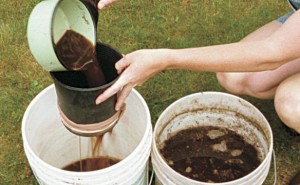1. Early spring applications of compost tea as a soil drench are used to boost orchard soil life and fertility, resulting in healthier, more resilient and productive fruit trees.
2. Foliar applications throughout the spring can provide further nutrient boosts and possibly aid in colonizing leaves and branches with beneficial microbes that may out-compete disease-causing fungi and bacteria.
3. Late fall applications after most leaves have dropped help to speed decomposition of fallen leaves and fruit, thus reducing the amount of disease pathogens remaining for the next year.
COMPOST TEA BREWING with KEVIN STUTLER
Can you give me a quick primer on what compost tea is and how it works?
Compost tea essentially extracts and promotes growth of beneficial microbes found in compost and vermicompost into a larger volume of water. Compost is suspended in vigorously aerated water for 12-16 hours and after which the compost is removed. The aeration is essential as it keeps the water oxygenated which promotes the multiplying of beneficial microorganisms and limits harmful microorganisms. I use an aquarium bubbler with water stones but a specific aeration device used for compost tea brewing can be purchased online.Compost tea will give a production boost to whatever you are trying to grow in your garden. The microbes extracted and multiplied producing compost tea encourage nutrient cycling in the soil. Plant foods are created and released by the burgeoning soil bacteria and fungi.
I see you use biodynamic certified compost for your compost tea, can we use backyard compost to make our compost tea?
It is acceptable to use backyard compost as long as it has been prepared correctly. For safety, you must start with a thermal compost that has been brought to 160 degrees Fahrenheit and turned a minimum of three times at this temperature. Worm castings from vermiculture are also a safe and effective compost for tea. Either of these sources will assure that you are not going to spread E. Coli through your tea. If both types of compost are available it is optimal to use 1 cup of each for a 5 gallon bucket of tea. If not, 2 cups of either compost will work just fine for a 5 gallon buckets worth of compost tea.
The primary advantage of the biodynamic compost is that it has been tested for the amount of beneficial bacteria and fungi as well as an harmful micro-organisms.
What else will I need besides an aeration device, the appropriate compost, and a 5 gallon bucket to make compost tea?
You need a mesh bag that will hold the compost in the 5 gallon bucket. I use a winemaking bag but you can also use panty hose. The bag of compost should rest at surface of the water during the aeration period.
All of these additions improve the micro-organism and nutrient content of the tea, although none of them individually is essential to make an effective tea.
If you are using chlorinated tap water, it is imperative to either let the water sit uncovered for 2 days or run your aeration device and let it tumble the water for 6 hours before adding the compost. Otherwise the chlorine can kill off certain beneficial organisms populations before you even begin!
What safety concerns are there about using compost tea?
HOW TO APPLY COMPOST TEA
After the brewing process is complete, the tea should be used within 6 hours. Dilute the finished tea 50-50 with un-chlorinated water. A backpack sprayer is the easiest means of application, although smaller sprayers can be used as well. Use a mesh bag or other filter as you fill the sprayer to avoid any blockage from larger particles. Using a larger concrete nozzle for your sprayer can also reduce the likelihood of blockage. Early spring and late fall soil drenches can also be done with a simple watering can!
For spring foliar sprays, use a backpack sprayer to cover all leaf, branch, and trunk surfaces evenly. As with all sprays, avoid applying during the heat of day and any time bees are active. A morning application time is best. Foliar sprays can be applied every couple weeks during spring.
RESOURCES:
Grow Organic Apples’ Guide to Holistic Spray Ingredients
Ready-made compost tea brewers and supplies:
This edition of POP TIPS prepared with assistance from POP intern Steve Palder and POP Orchard Committee member Kevin Stutler.
SUPPORT US! If you found this entry useful, informative, or inspiring, please consider a donation of any size to help POP in planting and supporting community orchards in Philadelphia: phillyorchards.org/donate.
